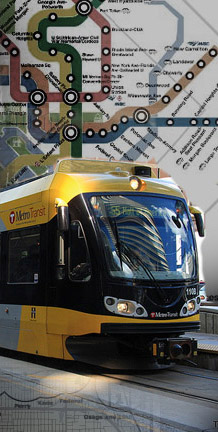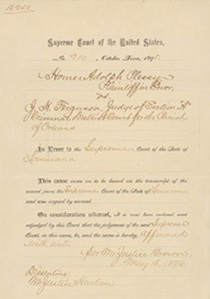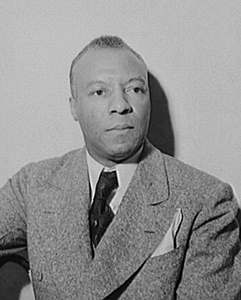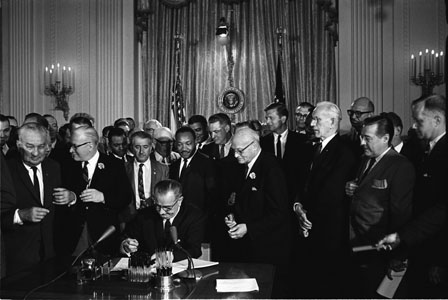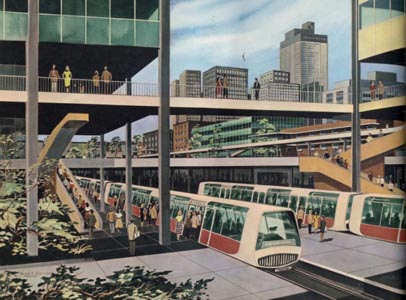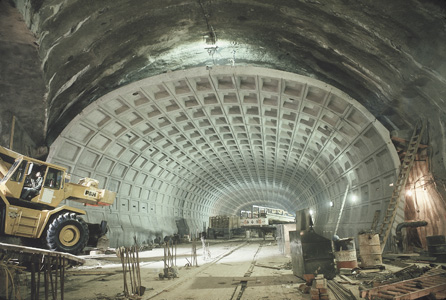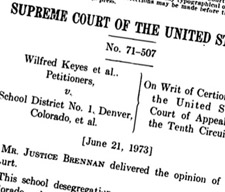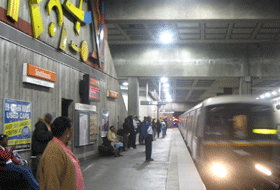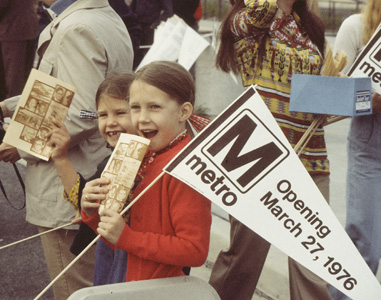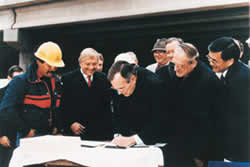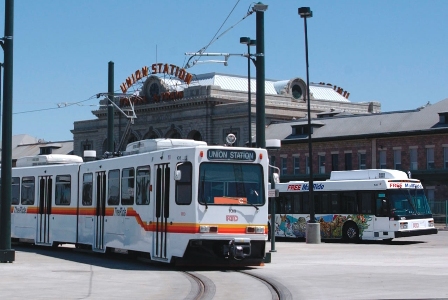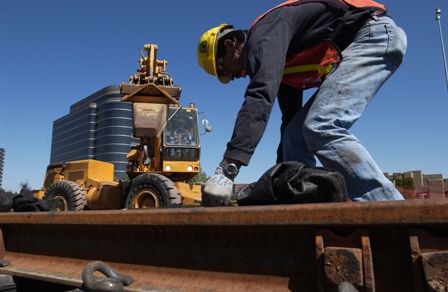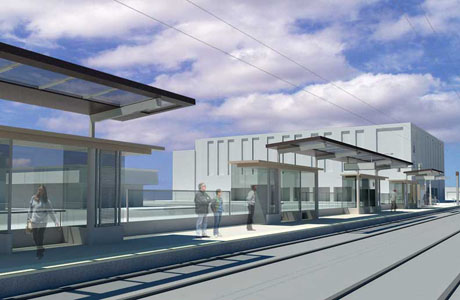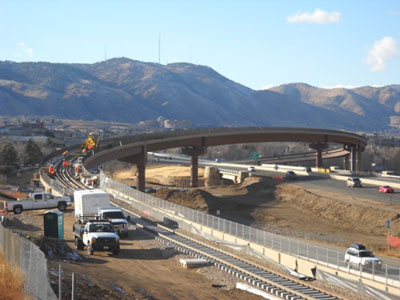 OAKLAND | Signs still mark the AC Transit bus routes where buses no longer run. Faced with a crippling deficit and union protests, the AC Transit board made a series of service cuts in 2010. Photo by Casey Miner
OAKLAND | Signs still mark the AC Transit bus routes where buses no longer run. Faced with a crippling deficit and union protests, the AC Transit board made a series of service cuts in 2010. Photo by Casey Miner OAKLAND | Ron Dacus used to take AC Transit to work until his bus line was eliminated in March 2010; now he walks several miles. Photo by Casey Miner
OAKLAND | Ron Dacus used to take AC Transit to work until his bus line was eliminated in March 2010; now he walks several miles. Photo by Casey Miner ST. PAUL | Peter Bell, former chairman of the Metropolitan Council, lost his childhood home to the construction of I-94. But he supports Central Corridor light-rail, in part because of the new investment it would bring to the neighborhoods along the line. Photo by Caroline Yang
ST. PAUL | Peter Bell, former chairman of the Metropolitan Council, lost his childhood home to the construction of I-94. But he supports Central Corridor light-rail, in part because of the new investment it would bring to the neighborhoods along the line. Photo by Caroline Yang ST. PAUL | Ora Lee Patterson, a former activist and St. Paul mayoral aide, said it was painful to watch the construction of Interstate 94 tear apart Rondo. Patterson sees parallels in the light-rail project now under construction. Photo by Laura Yuen
ST. PAUL | Ora Lee Patterson, a former activist and St. Paul mayoral aide, said it was painful to watch the construction of Interstate 94 tear apart Rondo. Patterson sees parallels in the light-rail project now under construction. Photo by Laura Yuen ST. PAUL | Nathaniel Khaliq, recently retired president of the St. Paul NAACP, stands on the frontage road along I-94. Khaliq's family was among the 650 families displaced during the construction of I-94 in the 1950s and 1960s, and now he is among the plaintiffs suing over the Central Corridor light-rail project. Photo by Caroline Yang
ST. PAUL | Nathaniel Khaliq, recently retired president of the St. Paul NAACP, stands on the frontage road along I-94. Khaliq's family was among the 650 families displaced during the construction of I-94 in the 1950s and 1960s, and now he is among the plaintiffs suing over the Central Corridor light-rail project. Photo by Caroline Yang ST. PAUL | St. Paul City Council Member Melvin Carter III says it's important that the residents and business owners situated along the Central Corridor light-rail line are the first to benefit from the new investment he's certain the new transit system would bring. Carter has deep roots in St. Paul's Rondo community, but says light-rail is not another Rondo. Photo by Laura Yuen
ST. PAUL | St. Paul City Council Member Melvin Carter III says it's important that the residents and business owners situated along the Central Corridor light-rail line are the first to benefit from the new investment he's certain the new transit system would bring. Carter has deep roots in St. Paul's Rondo community, but says light-rail is not another Rondo. Photo by Laura Yuen WASHINGTON D.C. | This home in the Dupont Circle neighborhood, close to the Metro, is worth $2 million. Photo by Andrea Bernstein
WASHINGTON D.C. | This home in the Dupont Circle neighborhood, close to the Metro, is worth $2 million. Photo by Andrea Bernstein WASHINGTON D.C. | This home outside Washington D.C. in Prince George's County, Maryland, is far from mass transit and worth about $365,000. Photo by Andrea Bernstein
WASHINGTON D.C. | This home outside Washington D.C. in Prince George's County, Maryland, is far from mass transit and worth about $365,000. Photo by Andrea Bernstein DENVER | Home values on the western side of Denver are expected to increase when the light rail system is constructed. Some local groups fear that property values will skyrocket, pushing out low-income minority residents. Photo by Andrea Bernstein
DENVER | Home values on the western side of Denver are expected to increase when the light rail system is constructed. Some local groups fear that property values will skyrocket, pushing out low-income minority residents. Photo by Andrea Bernstein DENVER | The Jody Apartments on Denver's west side are slated to be right next to a future light rail station. A coalition of conservancy and government groups is making sure the property remains affordable. Photo by Andrea Bernstein
DENVER | The Jody Apartments on Denver's west side are slated to be right next to a future light rail station. A coalition of conservancy and government groups is making sure the property remains affordable. Photo by Andrea Bernstein DENVER | South Lincoln Park, where new housing is being built near a rail station. Photo by Andrea Bernstein
DENVER | South Lincoln Park, where new housing is being built near a rail station. Photo by Andrea Bernstein

Click through the photos to see people and scenes from the story.

Click through the timeline or select a particular date to see important events for civil rights and mass transit.

See how the proximity of mass transit affects property values and demand.
-
Washington D.C. property values
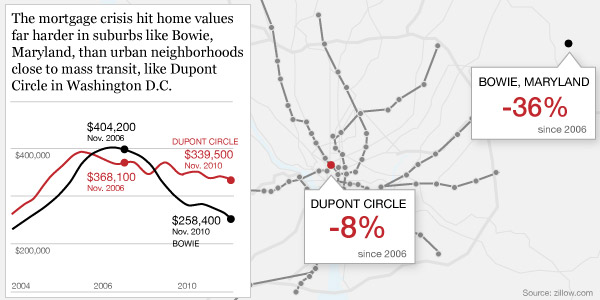
-
Denver housing demand and affordability
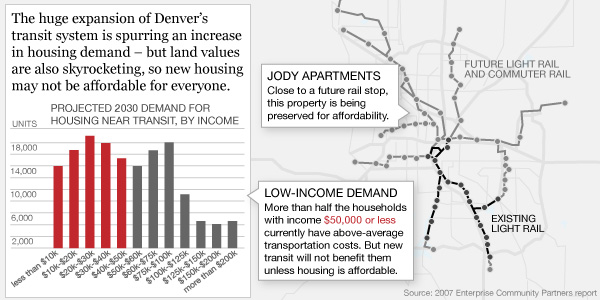

View mass transit maps from the featured cities. Click to drag or zoom.
-
Atlanta
Go to MARTA website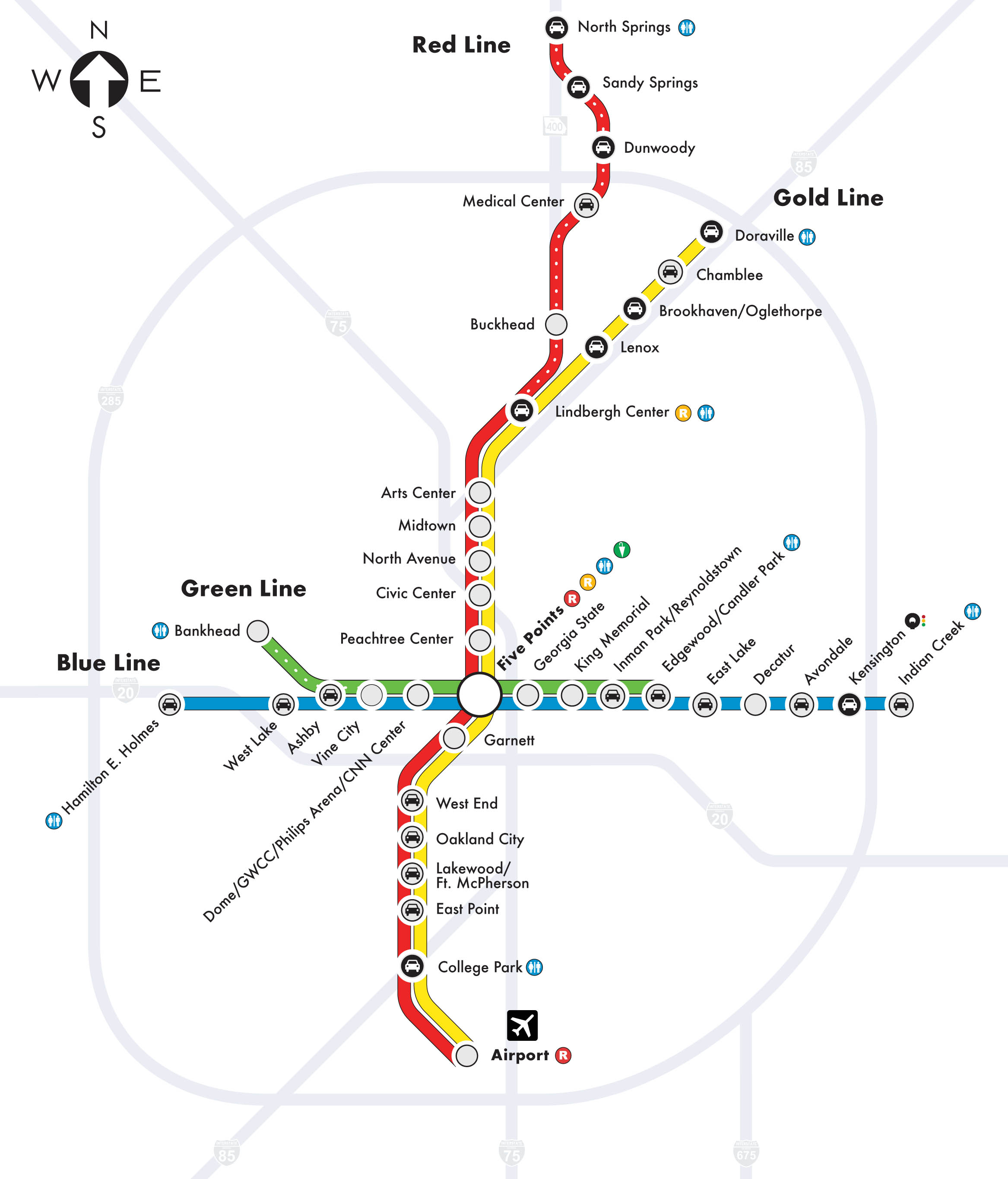
-
Bay Area
Go to Bay Area Rapid Transit website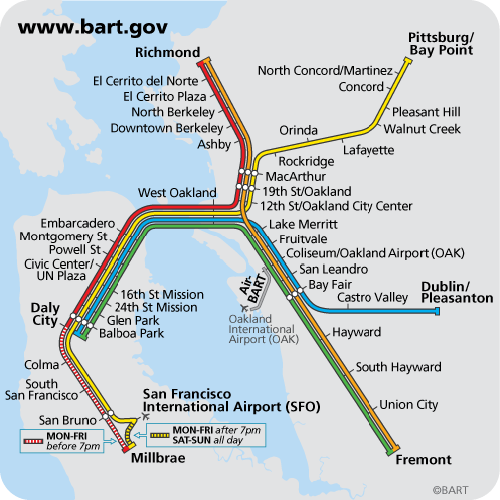
-
Washington D.C.
Go to WMATA website
-
Denver
Go to Regional Transportation District website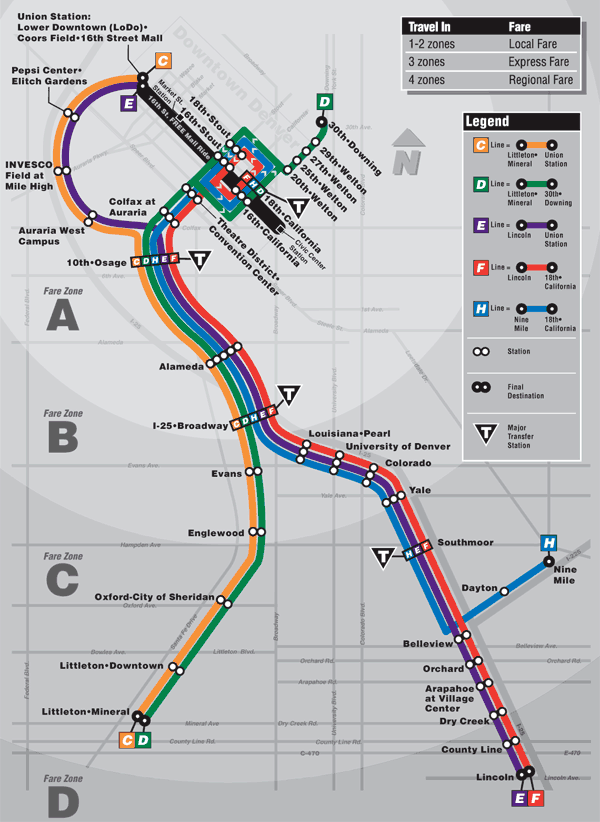
-
Minneapolis-St. Paul
Go to Metro Transit website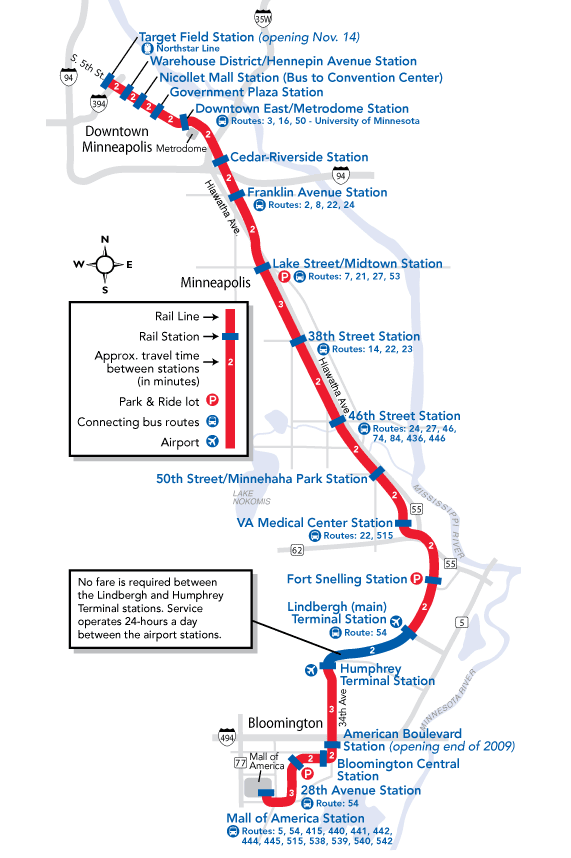
Back of the Bus: Mass transit, race and inequality
Fifty-six-year-old Carolyn McMillan considers herself lucky. To get to work, she can drive to the Home Depot parking lot on Jonesboro road in Clayton County Georgia, then take a bus to her clerical job in downtown Atlanta.
“I’m just barely making it,” McMillan says. “Because I have to put gas in the car. I’m just barely making it.” Not too long ago, McMillan could take a local bus before switching to the Atlanta system, or MARTA. But Clayton County isn’t part of MARTA, and last year, Clayton eliminated all bus service. Today it stretches south of Atlanta in an endless string of fried chicken joints, tattoo parlors, check-cashing stores and used car lots.
In the 1970s, when Clayton County voted not to become a part of MARTA, it was then a mostly white, rural place. Now, as more affluent whites flock to downtown Atlanta, Clayton County is mostly black.
“Transportation in Atlanta has always been mired in race and racism,” says Robert Bullard, director of the Environmental Justice Center at Clark Atlanta University. When Atlanta began building its commuter rail system in the 1970s, white communities like Clayton County wanted no part of it.
“Public Transit was equated with black people and poor people and crime and poverty. And when the Metropolitan Atlanta Transportation Authority was created MARTA, it was a running joke that MARTA” – he spells it out – M-A-R-T-A – “stood for moving Africans rapidly through Atlanta.”
“It’s transportation apartheid,” he says.
“One guy told me it takes him about 30 minutes to get here from where he lives, but if ladies are walking, it probably takes them longer,” McMillan said, as she walked from the bus to her car parked at the Home Depot. “Because I have walked, and it takes me about 40 minutes to walk from where I live to the bus stop.”
Listen to the full story.
Listen to the public radio documentary special: Back of the Bus: Mass Transit, Race, and Inequality.
Back of the Bus is also featured as the Feb. 18 edition of the American Radio Works podcast. For this and other documentary programs, subscribe here via iTunes.
Follow on Twitter: @TransportNation
More than half a century after Rosa Parks refused to move to the back of the bus in Montgomery, Alabama, prompting an 11-month boycott that led to integration of that city’s bus system, African Americans and Latinos are still struggling with an unequal transit system.
It’s a struggle that stretches far back. In 1896, a case over segregated rail cars made it to the U.S. Supreme Court Case. It was that case – Plessy v. Ferguson – that legalized the infamous concept of “separate but equal.”
It would take more than half a century for the legal precept to be overturned in the 1954 case, Brown v. Board of Education. But while the civil rights movement was playing out at schools, colleges, lunch counters and voting booths, a seemingly unrelated move by the federal government would change the way blacks and whites lived together for the next half century.
In 1956, President Dwight Eisenhower signed legislation that funded the interstate highway system. It was a seemingly unconnected event, but one that had enormous ramifications.
“At the same time we were doing Brown v. Board of Education and trying to integrate the school system,” says Angela Glover Blackwell, the head of PolicyLink, “we were investing billions of dollars in a highway system that segregated the nation by allowing people to be able to run away from urban areas that were integrated to suburban areas that were all white.”
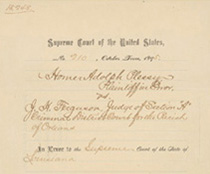
Plessy v. Ferguson, known for establishing the "separate but equal" concept, started from a dispute on a segregated rail car in Louisiana.
One of the communities that was destroyed was the Rondo neighborhood in St. Paul, Minnesota. Before the highway tore through that neighborhood, Rondo Avenue was a bustling commercial thoroughfare, chock-a-block with barber shops, churches, and shoe stores.
But in 1956, crews began leveling houses on Rondo Avenue to make way for Interstate 94. Nathanial Khaliq was 13 years old then.
“There were cop cars everywhere,” he recalls, “And when I walked into the house, these guys had axes and sledgehammers. They were knocking holes in the walls, breaking the windows, tearing up the plumbing – you know, just to make sure he didn’t try to move back in there. I was crying because it looked like something bad was happening.”
Ora Lee Patterson also grew up in Rondo. “To own your own home after you couldn’t vote, you weren’t considered as a human being – and then to see what happened with the freeway, and when they came through and gave them nickels and dimes for their property? They never gave those people what their houses were worth. Never.”
It was, Patterson and Khaliq’s families were assured, just good urban planning. But Marvin Anderson, a retired attorney and law librarian, spent years searching for evidence the government purposely selected the site of the freeway for all the wrong reasons. In 1993, he unearthed a letter to the editor of the St. Paul Pioneer Press. The writer, a city engineer, Claude Thompson, admitted the government chose the route for I-94 because it was in the city’s low-income black neighborhood.
Following the mass exodus of the middle class to American suburbs, cities experienced a gradual deterioration of schools and increasing poverty. Even today, transportation funding continues to help the suburbs at the expense of cities. Eighty percent of all transportation dollars are spent on roads. The remaining 20 percent is spent on mass transit.

Nathanial Khaliq stands along I-94, which tore apart his childhood neighborhood in St. Paul when it was constructed in the 1950s and 1960s. (Photo by Caroline Yang)
But the story of Rondo and transit inequality doesn’t end with the construction of I-94. Forty-five years after the highway came through, planners chose Rondo to build a commuter light-rail line to connect Minneapolis and St. Paul. The history of Rondo has generated a great deal of unease. “The lesson of Rondo is how long its shadow is – that it happened so long ago, but we’re still in the shadow of Rondo.”
Recent policy decisions didn’t help. Originally, under a Bush-Administration policy, the project wouldn’t even have stopped in Rondo. That policy funneled federal transit dollars to rail lines that traveled long distances – but made few stops, disfavoring neighborhoods like Rondo. At the same time, under the new plan, Rondo would lose its bus service.
But in January 2010, U.S. Transportation Secretary Ray LaHood announced that the Obama administration would shift the policy one hundred and eighty degrees. “There’s no question that this administration is going to take a careful look at civil rights compliance on the part of transit agencies,” Federal Transit Administrator Peter Rogoff says. “I think it’s fair to say there wasn’t a lot of attention paid to it in recent years.”
The government is paying attention now. In Oakland, California, Bay Area transit officials started planning a connector from the Oakland airport to downtown Oakland in the 1980s. The $500 million connector was slated to roll right through mostly African American Oakland neighborhoods, but, like the St. Paul line, skip through without stopping. At the same time, like every transit agency in the country right now, Oakland’s is underwater, and drastically cutting back on its bus service. Vast swaths have no buses, at all.
“Why are you looking to make an improvement for airline travelers, people who can afford an airline ticket, when people who live in that same community, who can barely afford a ticket, are looking at less service?” asks Lindsay Imai, who works for the non-profit transit advocacy group Urban Habitat.
Late last year, Urban Habitat and a few other nonprofits sued BART, saying it hadn’t done an analysis of how the project would affect the community it was built in. The groups won. It was the first time in the nation that activists had successfully challenged a transit project on the grounds that it violated the civil rights of local residents. The oversight cost BART $70 million dollars in federal funds.

Local groups successfully challenged the Oakland Airport Connector project, saying the civil rights impact wasn’t properly assessed.
But rail projects change communities in other ways. Atlanta, Washington D.C. and San Francisco all built their transit systems in the 1970s and 1980s – at a time when whites were fleeing American cities. In the original vision of planners, commuter rail lines would help suburban residents commute to work.
But those planners didn’t envision the new appetite for walkable neighborhoods near transit. Chris Leinberger, a visiting fellow at the Brookings Institution and a former real estate developer, says, once, he couldn’t build suburban homes fast enough.
But now, home buyers will pay a premium to live within walking distant to transit, according to an analysis Leinberger has done of real estate values. “We’re seeing anywhere from a forty to two hundred percent price premium,” Leinberger says. In Dupont Circle, a four-story town house costs $2 million. In the 1970s – just after riots tore apart DC in the wake of the murder of Dr. Martin Luther King Jr. – the same house cost virtually nothing.
Leinberger has made a chart of home values in what he calls “walkable, urban” neighborhoods, near transit, and “driveable, suburban.” For most of the latter half of the last century, he notes, driveable suburban homes rose in value faster than their urban counterparts. But in the middle of this decade, suburban values began to plummet, while urban homes held their value. The lines on the chart cross.
“The bulk of the mortgage meltdown took place here. It didn’t take place in Dupont,” Leinberger says during a driving tour of suburban Prince George’s county, which is now two-thirds African American. “And they moved out to suburbia, just as suburbia went over the edge,” Leinberger says. He’s standing in front of a large home with a big yard and a two-car garage. It looks like the American Dream. But without a transit stop, it’s worth about a fifth of the home in Dupont Circle.
This spike in urban land values around transit has not gone unnoticed. In 2004, Denver-area voters approved a ballot measure to vastly expand that city’s transit system by 150 miles – the largest such expansion in the country. But the news was also met with a gulp, says Karen Lado, Vice President of Enterprise Community Partners. “There was a huge flurry of discussion about really looking at this transit build-out as making the opportunity to make Denver a world class city. What there wasn’t was a discussion of affordability.”
Her colleague, Melinda Pollack, jumps in. “And so it was sort-of act now or the opportunity is going to be lost, not just on one little five-mile piece, it’s going to be lost over the entire system.”
Pollack and Lado have taken a reporter on a tour of the Jody Apartments, on the west side of Denver. The apartments look like an un-renovated 1950s motel – white metal stairs leading past brick up to a dark-green second story, the whole thing horseshoeing around a parking lot. But the Jody Apartments have become the unlikely site of a 21st century land rush – because they abut a new light rail station, within spitting distance of downtown Denver.
In 2007, Enterprise Community Partners warned that lots like the one that houses the Jody will be snapped up by market-rate developers, driving up the cost of affordable housing in Denver by 344 percent.
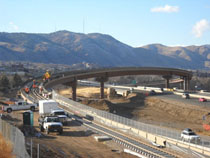
Developers are eager to buy land near future Denver transit stops, driving up the cost of affordable housing. (Photo courtesy of RTD FasTracks)
That’s already happening in the neighborhood of Five Points, an historically African American community with gorgeous 19th century homes. Aaron Miripol heads up a group called the Urban Land Conservancy, which is modeled after the Nature Conservancy. But instead of buying up land to keep it pristine, the ULC buys it near the rail line, to keep it affordable. As the light rail hums by in Five Points, he indicates a co-op that his group bid on, and lost. “We’ve bid on property and there were 25 other bids and not in a great location – you had investors from California, a number of out of state investors, that were bidding on this,” Miripol says.
The rush to keep Denver’s land affordable is particularly poignant, given that city’s racial history. African American and Mexican American families sued Denver’s school system over segregation in the 1970s – and the case became the first non-southern city desegregation case to be decided by the U.S. Supreme Court. The plaintiffs won, but Colorado voters then passed an amendment to the state constitution that prohibited Denver from growing or expanding its boundaries in any way. That effectively stopped the city from integrating the schools and Interstate 70 made it easy to move out to the suburbs.
“As a result of the Keyes case,” says Federico Pena, the former Mayor of Denver who later went on to hold two cabinet posts in the Clinton Administration, “a lot of the middle class families, largely white families, left Denver and went to the suburbs and that’s when the suburban explosion really occurred.” When he was elected in 1983, in an upset, Pena worked to rebuild Denver’s downtown, and was an early supporter of regional transit system.
Pena works in one of the buildings in a revivified downtown now, and from his conference room, there’s a stunning view of the sun fading over the Rockies. We ask Pena whether American cities will look back, fifty years from now, and compare light rail expansions like Denver’s to the highway boom of the 1950s – except in reverse. Will American city centers in 2050 be mostly upper-income, with everyone else living on the outskirts?
“It’s a good question,” Pena muses. “The day you sit back and say I don’t care, just let the economic market forces dictate who’s going to live where and what’s going to happen to your city, then I do think we run the risk of having almost a push out of low-income, minority communities away from our inner cities, and pushed out 20, 30 miles or 40 miles.”
That’s a form of 21st century segregation this city is trying to avoid.












